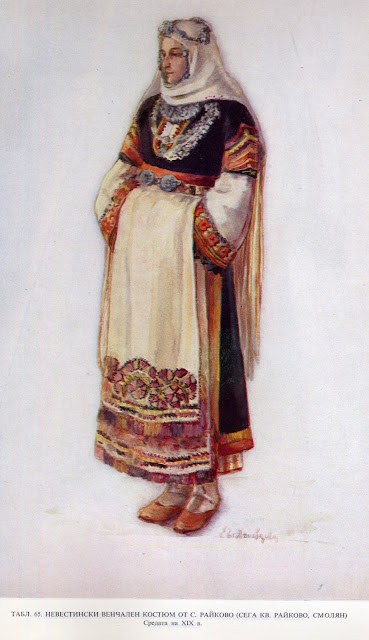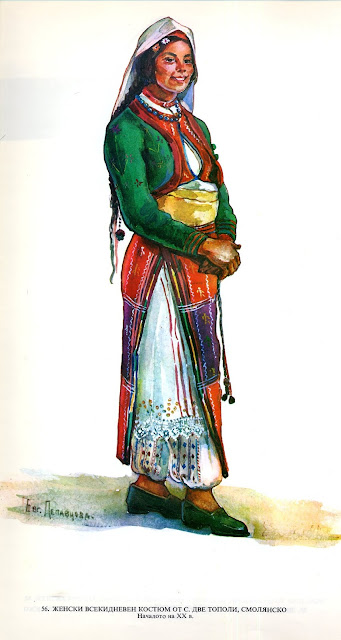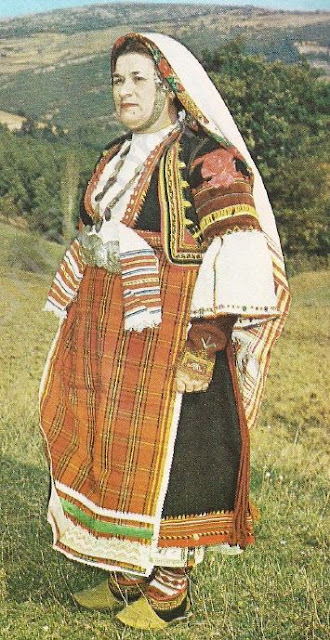This is the last installment of my series on the overview of Bulgarian costume. This covers the south of the country, specifically the cultural regions of Pirin and Rodop [Rhodope].
This includes the oblasts of Blagoevgrad, Smoljan and Krdzhali, as well as the southern parts of the oblasts of Pazardzik and Khaskovo.
The majority of the costumes of this region are of the saya type, with just a couple locations having the sukman type.
Pirin Region
Blagoevgrad Oblast
This is Bulgarian Macedonia. The borders do not exactly match the extent of the Pirin cultural region, as I would exclude both of the eastern corners, but it is close enough.
Pirin mountain lies in the center of this oblast, which thus is naturally divided into four districts. In the northeast, Razlog district, in the northwest, Blagoevgrad district, in the southwest, Sandanski district, and in the southeast, Gotse Delchev district.
Blagoevgrad district
Razlog district
This district lies in the northeast, and the costume shows some similarity with those of Thrace.
Sandanski district
The costume of this district is of the saya type, and belongs firmly in the Macedonian tradition. This is often presented as the most representative of Pirin Macedonia.
Gotse Delchev district
The costumes in this district are also of the saya type.
There are two major types of costume worn in this district. The first greatly resembles the typical Macedonian costume and is found in the west and the north.
These two images are labelled as being from the Nevrokop district, which is the old name for Gotse Delchev.
Banichan
This village is in the northwest of the district.
Kovachevitsa
This village is found in the northeast of this district.
Gaitaninovo
This village is found in the southwest of the district.
The second type of costume is influenced by Turkish costume, having bloomers and a saya with a more Turkish cut, as well as being made of textiles of a Turkish style. This costume is worn in the southeast, in the Rhodope mountains, as well as in some Bulgarian Muslim villages.
Dolen
This village is in the southeast of the district and has a mixed Muslim/Christian population.
Satovcha
This village is found even further east than Dolen, up in the mountains. It also has a mixed Muslim/Christian population.
Breznitsa
This village is in northwest Gotse Delchev district, but is majority Muslim. This is reflected in the costume.
The Rhodope mountains were strongly associated with Orpheus, the master musician of myth. This region is still known for its singers and the lyricism of its music. Whereas in most of Bulgaria women are known for singing and men for dancing, the men in the Rodop region sing as much as the women do.
The cultural region of Rodop includes Smolyan and Krdzhali oblasts, as well as the southern extensions of Plovdiv and Khaskovo oblasts.
Here is a video introducing the singing and music of the Rhodopes, the kaba gaida, the laments, the songs and dances.
https://www.youtube.com/watch?v=zI8kubL9_Mk
Smolyan Oblast
The costume of this oblast is often used to represent the Rodopes and Bulgaria in general, even though it is very distinctive.
The costume worn in the Smoljan district is of the sukman type.
The costume continued to develop in the 20th cent., acquiring a jacket with couched cord ornament. Sometimes two jackets were worn on top of each other. This is the costume which is usually seen today.
This photo is from the village of Yagodina.
Here is a half hour presentation of music and dance from the village of Stoykite
https://www.youtube.com/watch?v=VLPuU2UaZUc
This is an example of solo singing, one of the long slow songs which the Bulgarians love.
https://www.youtube.com/watch?v=6LParyW4v78
The Moslem community, known as Pomaks, have a distinctly different costume, based on the saya.
Krdzhali oblast Кърджали
This area has the saya style costume mostly. In the east, there are some examples of the sukman costume.
Starting from the north and moving counterclockwise around the province:
Pchelarovo Пчеларово
Rusalsko
This is a Turkish village
Musevo
Zhltusha Жълтуша
Pripek
Ustren or Ustra
- We have reached the southwest corner of Krdhzali province.
This is a Turkish village
Tihomir Тихомир
Tokachka
This is a Turkish village.
These are everyday costumes
Egrek
Avren
Chernichevo Черничево
We have reached the southeast corner of Krdzhali province.
Pelin
This is in east central Krdzhali province, and is a Turkish village.
Potochnitsa Поточница
This is in northeast Krdzhali province, and is also a Turkish village.
This next set of villages are found in the southern arm of Khaskovo province, which is
considered to be part of the Rhodope cultural area. I will cover them from north to south.
Kamilski Dol
Pokrovan
Ivaylovgrad Ивайловград
This is another example of a town costume
Ladzha
This was formerly a village which has become a quarter of Ivaylovgrad town. This is a more of a folk costume.
Drabishna
This looks like another town costume.
Svirachi
Mandritsa
This is an Albanian village, the only one in Bulgaria.
Dolno Lukovo
The next three villages, while considered to be part of the Rhodope cultural region, are found on the Greek side of the present border. Their Bulgarian population was resettled in Bulgaria, and the villages no longer exist.
The first two were found to the northeast of the Greek city of Komotini Κομοτηνή, in Turkish Gümülcine.
Manastir
The first image is of a bride.
Sachanli
This last village was found in the vicinity of the Greek town of Soufli Σουφλί, which lies at the eastern edge of Greece by the Turkish border.
Kayadzhik
This concludes my overview of the costumes of Bulgaria. I hope that you have found this to be interesting and informative.
Roman K.
rkozakand@aol.com






















































































































I would just like to know where you got the information that the villages mentioned as Turkish are such? Some of the women's costumes of these villages fall into the categories called "two-aproned" (Potochnitsa and the second image from Blagoevgrad, from Tserovo) and "one-aproned" (first image from Dolno Osenovo, Potochnitsa and Rusalsko). They and the man's white costume from Potochnitsa are considered archaic slavic remnants by most Bulgarian ethnographers. This is also written in the books from which a lot of the images are taken - the illustrated one by Maria Veleva and the album "Folk costumes from the Eastern Rhodopes" by Maria Nikolchovska. The Kardzhali museum, which houses examples of some of these, states the same, so I'm just wondering what source you used.
ReplyDeleteHello.
ReplyDeleteI looked up the various villages on wikipedia, mostly to find out exactly where they were, but also to get more information. I already knew that many Turkish people live in that area, and the Wikipedia articles explicitly state that some of the villages are populated by Turks. I felt that it would have been normal for costume pieces to be borrowed back and forth, especially if there were Pomak communities in the area.
Thank you for your fast reply. Yes, it is true that today they are mostly Turkish, but they were not (insofar as I know, as it is not stated in any ethnographic works, in contrast to other towns and villages) in the 19th and early 20th centuries, when these costumes were worn. In any case, I want to say that I really appreciate what you do here on your blog, it's amazing!
ReplyDeleteThank you for your input; i'm sure my readers will be interested. You correctly identified my main sources. It is a problem that often the ethnic population of an area is simply not well recorded, but rather which aristocrat ruled the area. I admit to being especially interested in border areas with mixed population. I try to obtain sources from both sides, but I cannot be proficient in all the languages of Europe. Do you know of any other sources for this area?
DeleteHmm, I don't know of any works that specifically recorded the ethnicity of the inhabitants in the areas, although there probably is. I just want to add that it's not a case of who ruled the area, since all of Bulgaria was ruled by the Ottomans for a long time.
DeleteThere is this collection of articles called "Народностна и битова общност на родопските българи" from 1969, where Maria Veleva has an article on the folk clothing of the Eastern Rhodopes(pages 57-117). I haven't read it though, and I am not sure if it's available in other languages (although usually articles like that have resumes in a couple different ones) You might find something there. Anything by Maria Veleva is good in general, she did a lot of work on the subject. Hristo Vakarelski as well, he has 3 volumes "Ethnography of Bulgaria", the second is about material culture and includes folk costumes, but is a bit more general. Also, you might turn to the museums of the regions, they should have full and objective information, including on the past ethnic makeup of the region. Good luck, and I would be happy if you share what you find.
Something interesting about the picture from Svirachi village - the women wear distinctive dresses from the Bulgarians of Asia Minor. They are refugees from there. The wars on the Balkans, during and after the dissolution of the Ottoman Empire, greatly changed the ethnographic environment in many areas and villages. It is very difficult sometimes to know just from Wikipedia or other online sources what villages were inhabited by what religion, and even less what ethnicity. Even the Ottoman archives, a huge part of which are in Bulgaria, are not good enough outside of the Muslim/Christina distinction and only before some point in time.
ReplyDeleteIn general you will never find Turkish dresses without shalvari. Women just never showed their legs unless they are Christian. This is a huge clue as to their religion.
I very interesting place to consider when researching clothes and hair (this is a whole subject on its own both for women and men), are the dialect maps. More often than not, the clothes will follow the dialectical affiliation, even if it's never a clear-cut line. Here is a nice dialect map of Bulgarian ethnicity (including Muslims and Roman Catholics) showing these distinctions. It is compiled by the Bulgarian Academy of Sciences and it's interactive:
http://ibl.bas.bg/bulgarian_dialects/
NB: The border dialects are obviously transitional ones, so it comes with its own territory of disputes but for the purposes of clothes and traditions this doesn't matter much. This map is more or less the Exarchate's borders.
I'm curious to know where the plaid clothes are worn the most, seems like it's Central Bulgaria.It could be Scythian influence cause they had some kind of tartan
ReplyDeleteIn this article, you have a number of images of real people wearing regional costumes posed against a dark grey background. See, for example, the seventh image under the Pirin Region. Can you please provide a complete citation for the source of these images?
ReplyDelete"Bulgarian Folk Costumes", by Anita Komitsa, published in Sofia in 2005 by Aniko. I actually have an extra copy.
ReplyDeleteDoes anyone know the costume from the Rhodope mtn region village formerly known as Pzelno (sp?). The village doesn’t exist any longer. That’s a family mystery since our dad, who was from there, is passed. If so can you direct me to the specific costume for that region. I think the closest one to there may be the yellow and orange plaid apron looking ones. I’d love to see the male and female costumes. Thanks for your help.
ReplyDelete